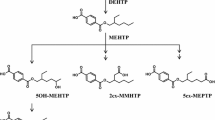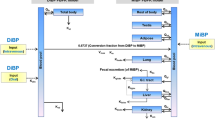Abstract
An individual (male, 36 years, 87 kg) ingested two separate doses of di-n-butyl phthalate (DnBP) and diisobutyl phthalate (DiBP) at a rate of ~60 μg/kg. Key monoester and oxidized metabolites were identified and quantified in urine continuously collected until 48 h post-dose. For both DnBP and DiBP, the majority of the dose was excreted in the first 24 h (92.2 % of DnBP, 90.3 % of DiBP), while only <1 % of the dose was excreted in urine on day 2. In each case, the simple monoesters were the major metabolites (MnBP, 84 %; MiBP, 71 %). For DnBP, ~8 % was excreted as various side chain oxidized metabolites. For DiBP, approximately 20 % was excreted mainly as the oxidized side chain metabolite 2OH-MiBP, indicating that the extent of oxidative modification is around 2.5 times higher for DiBP than for DnBP. All DnBP and DiBP metabolites reached peak concentrations between 2 and 4 h post-exposure, followed by a monotonic decline. For DnBP metabolites, the elimination halftime of MnBP was 2.6 h; longer elimination halftimes were estimated for the oxidized metabolites (2.9–6.9 h). For DiBP metabolites, MiBP had the shortest halftime (3.9 h), and the oxidized metabolites had somewhat longer halftimes (4.1 and 4.2 h). Together with the simple monoesters, secondary oxidized metabolites are additional and valuable biomarkers of phthalate exposure. This study provides basic human metabolism and toxicokinetic data for two phthalates that have to be considered human reproductive toxicants and that have been shown to be omnipresent in humans.




Similar content being viewed by others
References
Anderson WAC, Castle L, Scotter MJ, Massey RC, Springall C (2001) A biomarker approach to measuring human dietary exposure to certain phthalate diesters. Food Addit Contam 18(12):1068–1074. doi:10.1080/02652030110050113
Calafat AM, Silva MJ, Reidy JA et al (2006) Mono-(3-carboxypropyl) phthalate, a metabolite of di-n-octyl phthalate. J Toxicol Environ Health A Curr Issues 69(3):215–227. doi:10.1080/15287390500227381
Clark K, David RM, Guinn R, Kramarz KW, Lamp MA, Staples CA (2012) Modelling human exposure to phthalate esters: a comparison of indirect and biomonitoring estimation methods. J Hum Ecol Risk Assess 17(4):923–965. doi:10.1080/10807039.2011.588157
ECB (2004) Dibutyl phthalate. Vol. 1st priority list volume 29. EUR 19840 EN. European Union risk assessment report. European Chemicals Bureau
EFSA (2005) Opinion of the scientific panel on food additives, flavourings, processing aids and materials in contact with food (AFC) on a request from the Commission related to Di-Butylphthalate (DBP) for use in food contact materials. Question No. EFSA-Q-2003-192. EFSA J 242:1–17. European Food Safety Authority
Engel SM, Miodovnik A, Canfield RL et al (2010) Prenatal phthalate exposure is associated with childhood behavior and executive functioning. Environ Health Perspect 118(4):565–571. doi:10.1289/Ehp.0901470
EPA (1990) Dibutyl phthalate (CASRN 84-74-2). United States Environmental Protection Agency, Integrated Risk Information System. http://www.epa.gov/iris/subst/0038.htm. Accessed July 2012
Habert R, Muczynski V, Lehraiki A et al (2009) Adverse effects of endocrine disruptors on the foetal testis development: focus on the phthalates. Folia Histochem Cytobiol 47(5):S67–S74. doi:10.2478/v10042-009-0056-5
Hatch EE, Nelson JW, Qureshi MM et al (2008) Association of urinary phthalate metabolite concentrations with body mass index and waist circumference: a cross-sectional study of NHANES data, 1999–2002. Environ Health Glob 7. doi:10.1186/1476-069x-7-27
Hauser R, Calafat AM (2005) Phthalates and human health. Occup Environ Med 62(11). doi:10.1136/oem.2004.017590
Hauser R, Meeker JD, Duty S, Silva MJ, Calafat AM (2006) Altered semen quality in relation to urinary concentrations of phthalate monoester and oxidative metabolites. Epidemiology 17(6):682–691. doi:10.1097/01.ede.0000235996.89953.d7
Heikkila P, Kemppainen T, Kirsila T, Korhonen P (2010) BeST—Bioequivalence Study Templat. Paper presented at the Pharmaceutical Users Software Exchange, Berlin, Germany, October 14–17, 2010
Hernandez-Diaz S, Mitchell AA, Kelley KE, Calafat AM, Hauser R (2009) Medications as a potential source of exposure to phthalates in the US population. Environ Health Perspect 117(2):185–189. doi:10.1289/Ehp.11766
Hong YC, Park EY, Park MS et al (2009) Community level exposure to chemicals and oxidative stress in adult population. Toxicol Lett 184(2):139–144. doi:10.1016/j.toxlet.2008.11.001
Huang PC, Kuo PL, Chou YY, Lin SJ, Lee CC (2009) Association between prenatal exposure to phthalates and the health of newborns. Environ Int 35(1):14–20. doi:10.1016/j.envint.2008.05.012
Huang PC, Tsai EM, Li WF et al (2010) Association between phthalate exposure and glutathione S-transferase M1 polymorphism in adenomyosis, leiomyoma and endometriosis. Hum Reprod 25(4):986–994. doi:10.1093/humrep/deq015
Kasper-Sonnenberg M, Koch HM, Wittsiepe J, Wilhelm M (2012) Levels of phthalate metabolites in urine among mother-child-pairs—results from the Duisburg birth cohort study, Germany. Int J Hyg Environ Health 215(3):373–382. doi:10.1016/j.ijheh.2011.09.004
Kavlock R, Boekelheide K, Chapin R et al (2002) NTP Center for the evaluation of risks to human reproduction: phthalates expert panel report on the reproductive and developmental toxicity of di-n-butyl phthalate. Reprod Toxicol 16(5):489–527. doi:10.1016/S0890-6238(02)00033-3
Kelley KE, Hernandez-Diaz S, Chaplin EL, Hauser R, Mitchell AA (2011) Identification of phthalates in medications and dietary supplements. Pharmacoepidemiol Drug Saf 20:S37
Kim BN, Cho SC, Kim Y et al (2009) Phthalates exposure and attention-deficit/hyperactivity disorder in school-age children. Biol Psychiatry 66(10):958–963. doi:10.1016/j.biopsych.2009.07.034
Kim Y, Kim BN, Kim EJ et al (2011) Perinatal exposure to environmental phthalate and the cognitive development of 6-month-old infants (MOCEH Study). Epidemiology 22(1):S285
Koch HM, Angerer J (2007) Di-iso-nonylphthalate (DINP) metabolites in human urine after a single oral dose of deuterium-labelled DINP. Int J Hyg Environ Health 210(1):9–19. doi:10.1016/j.ijheh.2006.11.008
Koch HM, Calafat AM (2009) Human body burdens of chemicals used in plastic manufacture. Philos Trans R Soc B Biol Sci 364(1526):2063–2078. doi:10.1098/rstb.2008.0208
Koch HM, Bolt HM, Angerer J (2004) Di(2-ethylhexyl)phthalate (DEHP) metabolites in human urine and serum after a single oral dose of deuterium-labelled DEHP. Arch Toxicol 78(3):123–130. doi:10.1007/00204-003-0522-3
Koch HM, Bolt HM, Preuss R, Angerer J (2005a) New metabolites of di(2-ethylhexyl)phthalate (DEHP) in human urine and serum after single oral doses of deuterium-labelled DEHP. Arch Toxicol 79(7):367–376. doi:10.1007/s00204-004-0642-4
Koch HM, Preuss R, Drexler H, Angerer J (2005b) Exposure of nursery school children and their parents and teachers to di-n-butylphthalate and butylbenzylphthalate. Int Arch Occup Environ Health 78(3):223–229. doi:10.1007/s00420-004-0570-x
Koch HM, Becker K, Wittassek M, Seiwert M, Angerer J, Kolossa-Gehring M (2007a) Di-n-butylphthalate and butylbenzylphthalate—urinary metabolite levels and estimated daily intakes: pilot study for the German Environmental Survey on children. J Eposure Sci Environ Epidemiol 17(4):378–387. doi:10.1038/sj.jes.7500526
Koch HM, Muller J, Angerer J (2007b) Determination of secondary, oxidised di-iso-nonylphthalate (DINP) metabolites in human urine representative for the exposure to commercial DINP plasticizers. J Chromatogr B 847(2):114–125. doi:10.1016/j.jchromb.2006.09.044
Koch HM, Haller A, Weiß T, Käfferlein HU, Stork J, Brüning T (2012) Phthalate exposure during cold plastisol application-A human biomonitoring study. Toxicol Lett. doi:10.1016/j.toxlet.2011.06.010
Larsen K (1972) Creatinine assay by a reaction-kinetic principle. Clin Chim Acta 41(1):209–217
Lorber M, Angerer J, Koch HM (2010) A simple pharmacokinetic model to characterize exposure of Americans to Di-2-ethylhexyl phthalate. J Eposure Sci Environ Epidemiol 20(1):38–53. doi:10.1038/jes.2008.74
Lorber M, Koch HM, Angerer J (2011) A critical evaluation of the creatinine correction approach: can it underestimate intakes of phthalates? A case study with di-2-ethylhexyl phthalate. J Eposure Sci Environ Epidemiol 21(6):576–586. doi:10.1038/Jes.2010.43
Lyche JL, Gutleb AC, Bergman A et al (2009) Reproductive and developmental toxicity of phthalates. J Toxicol Environ Health B Crit Rev 12(4):225–249. doi:10.1080/10937400903094091
Martino-Andrade AJ, Chahoud I (2010) Reproductive toxicity of phthalate esters. Mol Nutr Food Res 54(1):148–157. doi:10.1002/mnfr.200800312
Meeker JD, Hu H, Cantonwine DE et al (2009a) Urinary phthalate metabolites in relation to preterm birth in Mexico City. Environ Health Perspect 117(10):1587–1592. doi:10.1289/Ehp.0800522
Meeker JD, Sathyanarayana S, Swan SH (2009b) Phthalates and other additives in plastics: human exposure and associated health outcomes. Philos Trans R Soc B Biol Sci 364(1526):2097–2113. doi:10.1098/rstb.2008.0268
Miodovnik A, Engel SM, Zhu CB et al (2011) Endocrine disruptors and childhood social impairment. Neurotoxicology 32(2):261–267. doi:10.1016/j.neuro.2010.12.009
Pant N, Shukla M, Patel DK et al (2008) Correlation of phthalate exposures with semen quality. Toxicol Appl Pharmacol 231(1):112–116. doi:10.1016/j.taap.2008.04.001
Pant N, Pant AB, Shukla M, Mathur N, Gupta YK, Saxena DK (2011) Environmental and experimental exposure of phthalate esters: the toxicological consequence on human sperm. Hum Exp Toxicol 30(6):507–514. doi:10.1177/0960327110374205
SAS (2011) Version 9.3 of the SAS System for Windows. Copyright ©2011 SAS Institute Inc. SAS and all other SAS Institute Inc. product or service names are registered trademarks or trademarks of SAS Institute Inc., Cary, NC, USA
Schütze A, Palmke C, Angerer J, Weiss T, Brüning T, Koch HM (2012) Quantification of biomarkers of environmental exposure to di(isononyl)cyclohexane-1,2-dicarboxylate (DINCH) in urine via LC/LC-MS/MS. J Chromatogr B doi:10.1016/j.jchromb.2012.03.030
Seckin E, Fromme H, Volkel W (2009) Determination of total and free mono-n-butyl phthalate in human urine samples after medication of a di-n-butyl phthalate containing capsule. Toxicol Lett 188(1):33–37. doi:10.1016/j.toxlet.2009.03.002
Silva MJ, Barr DB, Reidy JA et al (2004) Urinary levels of seven phthalate metabolites in the US population from the National Health and Nutrition Examination Survey (NHANES) 1999–2000. Environ Health Perspect 112(3):331–338. doi:10.1289/ehp.6723
Silva MJ, Reidy JA, Samandar E, Herbert AR, Needham LL, Calafat AM (2005a) Detection of phthalate metabolites in human saliva. Arch Toxicol 79(11):647–652. doi:10.1007/s00204-005-0674-4
Silva MJ, Samandar E, Preau JL, Reidy JA, Needham LL, Calafat AM (2005b) Automated solid-phase extraction and quantitative analysis of 14 phthalate metabolites in human serum using isotope dilution-high-performance liquid chromatography-tandem mass spectrometry. J Anal Toxicol 29(8):819–824. doi:10.1093/jat/29.8.819
Silva MJ, Samandar E, Reidy JA, Hauser R, Needham LL, Calafat AM (2007) Metabolite profiles of di-n-butyl phthalate in humans and rats. Environ Sci Technol 41(21):7576–7580. doi:10.1021/Es071142x
Silva MJ, Furr J, Samandar E et al (2011) Urinary and serum metabolites of di-n-pentyl phthalate in rats. Chemosphere 82(3):431–436. doi:10.1016/j.chemosphere.2010.09.052
Stahlhut RW, van Wijngaarden E, Dye TD, Cook S, Swan SH (2007) Concentrations of urinary phthalate metabolites are associated with increased waist circumference and insulin resistance in adult US males. Environ Health Perspect 115(6):876–882. doi:10.1289/ehp.9882
Swan SH (2008) Environmental phthalate exposure in relation to reproductive outcomes and other health endpoints in humans. Environ Res 108(2):177–184. doi:10.1016/j.envres.2008.08.007
Swan SH, Main KM, Liu F et al (2005) Decrease in anogenital distance among male infants with prenatal phthalate exposure. Environ Health Perspect 113(8):1056–1061. doi:10.1289/ehp.8100
Weuve J, Hauser R, Calafat AM, Missmer SA, Wise LA (2010) Association of exposure to phthalates with endometriosis and uterine leiomyomata: findings from NHANES, 1999–2004. Environ Health Perspect 118(6):825–832. doi:10.1289/Ehp.0901543
Whyatt R, Arias F, Calafat A, Rauh V, Factor-Litvak P (2011) Associations between maternal prenatal phthalate urinary metabolite concentrations and child mental and motor development at age 3 years. Epidemiology 22(1):S126–S127
Wittassek M, Koch HM, Angerer J, Bruning T (2011) Assessing exposure to phthalates—the human biomonitoring approach. Mol Nutr Food Res 55(1):7–31. doi:10.1002/mnfr.201000121
Wolff MS, Teitelbaum SL, Pinney SM et al (2010) Investigation of relationships between urinary biomarkers of phytoestrogens, phthalates, and phenols and pubertal stages in girls. Environ Health Perspect 118(7):1039–1046. doi:10.1289/ehp.0901690
Wormuth M, Scheringer M, Vollenweider M, Hungerbuhler K (2006) What are the sources of exposure to eight frequently used phthalic acid esters in Europeans? Risk Anal 26(3):803–824. doi:10.1111/j.1539-6924.2006.00770.x
Zhang YH, Zheng LX, Chen BH (2006) Phthalate exposure and human semen quality in Shanghai: a cross-sectional study. Biomed Environ Sci 19(3):205–209
Zhang YH, Lin L, Cao Y, Chen BH, Zheng LX, Ge RS (2009) Phthalate levels and low birth weight: a nested case-control study of chinese newborns. J Pediatr 155(4):500–504. doi:10.1016/j.jpeds.2009.04.007
Conflict of interest
The authors declare that they have no conflict of interest.
Author information
Authors and Affiliations
Corresponding author
Additional information
Disclaimer This manuscript has been reviewed by the US Environmental Protection Agency and approved for publication. The views expressed in this manuscript are those of the authors and do not necessarily reflect the views or policies of the US Environmental Protection Agency.
Electronic supplementary material
Below is the link to the electronic supplementary material.
Rights and permissions
About this article
Cite this article
Koch, H.M., Christensen, K.L.Y., Harth, V. et al. Di-n-butyl phthalate (DnBP) and diisobutyl phthalate (DiBP) metabolism in a human volunteer after single oral doses. Arch Toxicol 86, 1829–1839 (2012). https://doi.org/10.1007/s00204-012-0908-1
Received:
Accepted:
Published:
Issue Date:
DOI: https://doi.org/10.1007/s00204-012-0908-1




